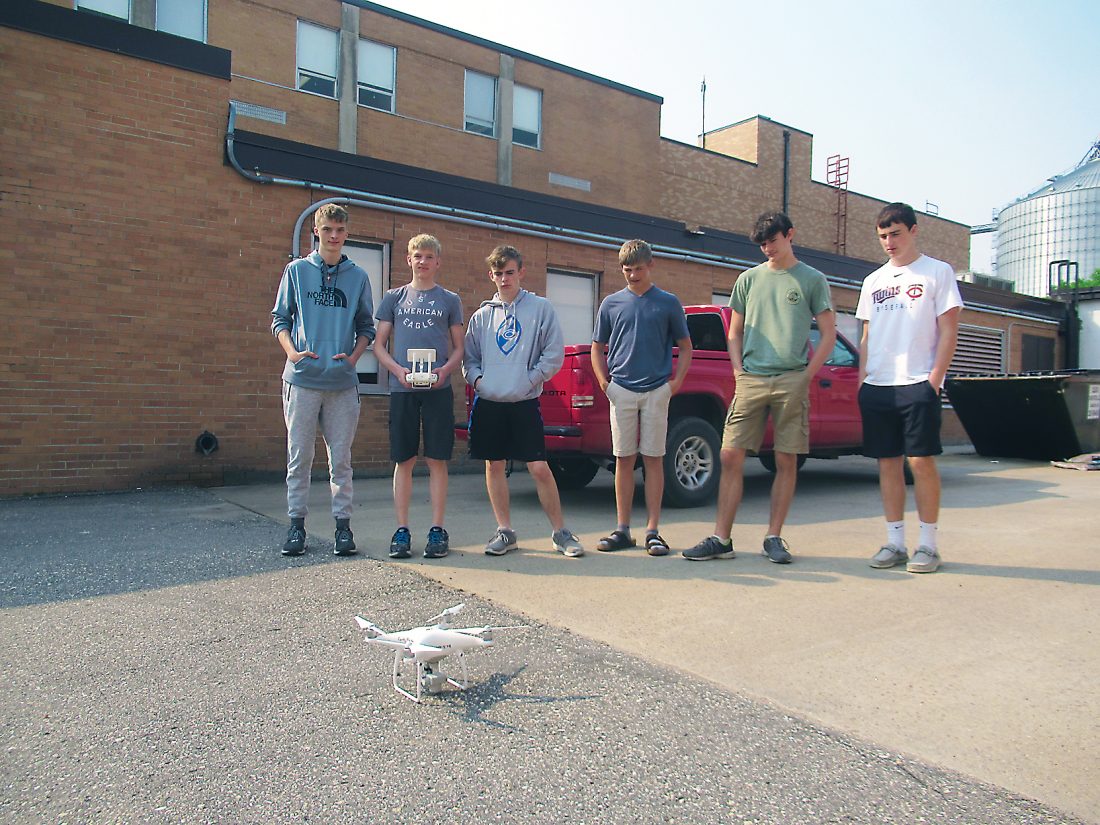Reaching new heights
Canby High School students can add aviation as a possible career choice or hobby thanks to courses offered by the school. Those not wanting to get in the pilot’s seat can opt for a class in operating drones.

Photo by Jim Muchlinski Drones fly anywhere that they can pick up a satellite signal, even in narrow spaces such as the drive-up area between two portions of a school campus.
CANBY
The wild blue yonder is by no means a limit for Canby High School teenagers who decide to study aviation and drone technology.
The school’s aviation class, which has a 10-year history, includes the opportunity for students to obtain a pilot’s license. A second course, focused on drone technology, wrapped up its first full year in May.
Much of both subjects involves hands-on learning. An aviation simulator leads to a firsthand impression of the view from an airplane cockpit with actual flight control switches. A fully-functioning drone that belongs to the school district, guided by remote control, performs the same flight processes as counterparts used to gather information in a variety of commercial and government settings.
The idea for flight-related classes at the high school took shape when Canby faculty member Dan Lutgen, who teaches both the aviation and drone classes, experienced the advantages of air travel during a visit to Alaska.
Known as the Last Frontier, Alaska is by far the largest of all 50 states in land area. Much of it is divided by high mountain ranges, as well as the vast network of islands and bays referred to as the Inside Passage.
“I saw how much of a difference air travel can make, and how it could mean even more in the future as technology continues to improve,” Lutgen said. “Being able to pilot a plane is a valuable skill that can be learned at a young age.”
Lutgen completed his ground school instruction license in 2007. He then created a proposal to begin aviation instruction at the high school level, which was approved by former Canby School District Superintendent Loren Hacker.
A decade later, the Canby district is in the process of offering aviation training to other high schools within a reasonable driving distance.
“It would be cost effective for high schools to share the same resources,” Lutgen said. “Most of the class sessions could take place with online and interactive video technology.”
Students who took part in the aviation class this year said the opportunity to become qualified as a pilot was a main motivation to enroll.
“It’s easier than I thought it would be,” said Canby High School junior Jake Wagner. “It just takes practice. Once we get experience operating the controls, it comes naturally.”
Wagner and several of his classmates said they thought about becoming professional pilots at an early age, as soon as they were old enough to be impressed when they’d see a plane flying overhead.
They said their high school aviation class was a good way to learn about the many different requirements of being ready to pilot an aircraft.
“I learned there’s more to it than I thought at first,” said student Jack Nemitz. “It means keeping track of jet fuel, weather, flight plans, airspace and air traffic laws; everything that happens behind the scenes.”
Student Brady Gravdal said another reason to be interested in aviation career possibilities is that many flight crew members who’ve spent most of their careers traveling between airports are reaching retirement age.
“It’s a good time for high school and college students to think about getting started in it,” Gravdal said. “Many more people fly now than in the past because they want to see other parts of the world. They’re also more likely to travel by air for business reasons at least two or three times a year.”
Canby High School’s first-ever drone class led to the same kind of benefits. Students said they learned about the many ways drones have started to play important roles in a variety of professional settings.
One of them is crop production, since drone flights can produce valuable video footage that would be almost impossible to collect strictly with ground level observations or helicopter flights.
Drones can identify levels of crop maturity, the size of areas in a field that might be under water after heavy rain, pockets of a field that no longer have harvestable crops because of weather damage, and the extent of weed encroachment in field sections.
The class also learned firsthand about how drones are useful for the sale of houses, new housing lots, commercial property, and farm sites. Their drone flights and video editing resulted in marketing material for property located on Lake Cochrane, a border lake situated west of Canby on the Minnesota and South Dakota border.
Another growing purpose for drones is search and rescue operations. A drone can often be used as a much more versatile way of locating victims, both because of their small size and because of how the potential loss of a drone is far less of a concern than exposing emergency crew members to high-risk situations at the rescue site.
Class participants learned that much of the drone technology, which originally took shape in the armed forces for military scouting is steadily being adapted for similar uses in civilian life. As the technology continues to flourish, more new uses are likely to emerge.
“There are many good ways to use them because they’re small, portable and easy to control,” said Canby High School student Andrew Thorpe. “They’re not much harder to use than a joystick for a video game. Manufacturers are creating them for average consumers, with instructions that someone can follow after taking it out of the box.”






